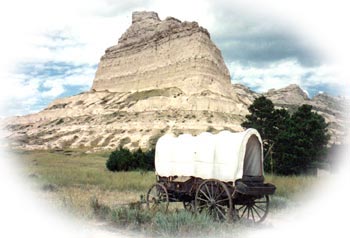
Following the opening or rediscovery of the Platte River route to the west by the fur traders and mountain men of the 1820's and 1830's, it was natural that other parties should use this same route to find their way to the newly opened Oregon country, to the gold fields of California, and to a religious haven in Utah.
John Ball is credited with the first Oregon secular settlement in 1832. Others followed, but not until 1841 did a large covered wagon train make the entire route. The mass migration began in 1843 when over 1,000 people started for the great northwestern country in May. The peak year of travel was evidently 1852 when some 50,000 emigrants passed through Mitchell Pass. Most of these were on their way to California as part of the great Gold Rush. Travel on the Oregon Trail continued until 1869 when the country was linked by the Union Pacific railroad, up the Lodgepole Route, 50 miles to the south of Scotts Bluff.
Until about 1851, the pioneers used Robidoux Pass, located nine miles southwest of the National Monument. Travel between Scotts Bluff and the river was impossible due to eroded gullies and badlands. A new route to the north through the bluffs via present Mitchell Pass was developed in 1850. The Monument headquarters and the Oregon Trail Museum are situated near Mitchell Pass.
Besides the pioneer wagon trains passing through Mitchell Pass, a number of other uses were made of the trail. The Pony Express used this section of the trail from April 1860, until its last run in October, 1861. Nearby Pony Express stations included one at Chimney Rock, 23 miles east of Scotts Bluff; Ficklin Springs, about 9 miles east; the Scotts Bluff station, 3 miles west of Mitchell Pass; and Horse Creek, about 18 miles to the west.
